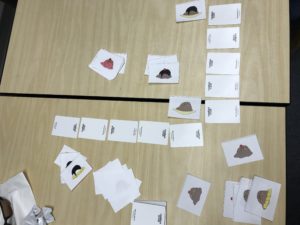
To show off the brilliant mind of John Kean, we wanted to share some of his thought process while making Black Sonata. This series of posts are pulled from his Work In Progress thread on BoardGameGeek. Here’s part 2:
ANOTHER POTENTIAL MECHANIC?
30 May 2017
It’s 2am and I’m awake thinking about one of the suggestions posted above…
Say you had ten locations labelled 0 to 9. There are two pawns – one representing you and the other a spy with whom you need to rendezvous. You have a “code wheel” with two circles of card, slightly different sizes, pinned at the centre so that you can rotate them relative to each other. Each circle has the numbers 0 to 9 spaced evenly around the outside, and the top (smaller) circle has a small window cut into it.
Each turn you must place your pawn where you think the spy will go next. Then align the number corresponding to your pawn’s previous location (outside wheel) with that of the spy pawn (inside circle). Now a number is visible through the window, and determines the next location of the spy pawn. If you got it right, you and the spy will be in the same location and a clue is exchanged.
So your challenge is to deduce the pattern underlying the wheel. I’m guessing it will somehow involve modular arithmetic but will need to check that out… (not now – it’s 2am). The game could include several different wheels of each size and you’d choose some combination at random at the start of the game. Maybe there could be more than one window. Maybe the locations would be named rather than numbered, to make it harder.
This could work, I think, as long as the underlying maths is sound. I have no idea if it is yet, but will investigate further…
PROTOTYPE DEDUCTION MECHANIC
OK, I have put together a simple one-page PnP prototype for a deduction mechanism that seems to work (I think!). I have wrapped a simple pseudo-game around it, mostly as a way to test how many clues are needed to make the deduction (it seems to vary, but I haven’t had a chance yet to look at it more systematically).
I am excited because this seems to create a nice “if that then this OR that” logic puzzle that is not just about eliminating possibilities.
NOTE: Do not study the cards and try to discover the patterns or memorise their symbols! This will ruin the deductive element and spoil the game for you.
Please, if you do try it out, can you report back on how you got on. Useful data would be the “suit” of the hidden card and how many clues it took to correctly deduce its symbols. In lieu of that, your score would be almost as helpful. Thanks!
Here’s the link: THIS IS NOT THE FINAL GAME
Meanwhile, I need to start thinking about a theme. I have a couple of off-the-wall ideas, but I need to digest them for a few days (and do some research!). More news soon…

